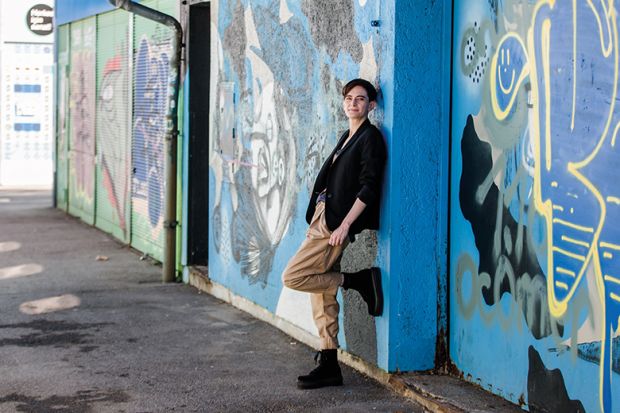“There is a trope in anthropology of heroic ethnographers putting themselves in some kind of dangerous fieldwork situation for the sake of science,” says Steph Grohmann, research fellow at the University of Edinburgh’s Centre for Homeless and Inclusion Health. But although she was herself homeless during much of the research that underlies her powerful new book, The Ethics of Space: Homelessness and Squatting in Urban England, this was in no way a “heroic” choice.
In 2010, Grohmann was two months into the research for a PhD at Goldsmiths, University of London, examining life within a non-monetary economy around Bristol’s squatting community. She was living in rented accommodation, but after complaining about the state of her building, she became the victim of a “revenge eviction”. As a result, she found herself “actually homeless” and moved into a squat herself “because I had some squatter friends”. She remained homeless for two-thirds of the 18 months she spent “in the field” in Bristol.
The Ethics of Space makes a number of wide-ranging arguments about access to and exclusion from space, and the UK’s largely unchanging patterns of land ownership. But it also provides many vivid glimpses of Grohmann’s own experiences. She lived in squats, a caravan, a Land Rover and a collective shop; she even briefly squatted in squats: “probably as low as one can get short of sleeping rough”. She shows us what it is like to join an “occupation crew”, breaking into an empty building and setting up home there. She describes being evicted from a squat for the first of more than a dozen times. And she depicts the “emergency crowds” that would gather to prevent the enforcement of possession orders.
At one point, we find her living in a “‘high-security’ squat…permanently surrounded by screaming sirens, the noise of helicopters flying low, and the intrusive finger of the police searchlight shining into the yard at all hours of night”. However, because squatting was then a civil rather than a criminal matter, the police were often reluctant to get involved in evictions: “it sometimes took as little as a conveniently staged ‘Christmas market’ with a couple of stalls right in front of the squat’s door to turn them away.”
Grohmann’s fieldwork coincided with the early days of the UK’s Conservative-Liberal Democrat coalition government, which came to power in 2010 under David Cameron. This period was notable for a good deal of windy rhetoric about what Cameron – seeking to temper the Conservative Party’s harsh image – called the “Big Society”. But this coincided with what Grohmann’s book describes as “a two-year-long publicity campaign on the part of the government and the tabloid media, designed to shift the public perception of ‘the squatter’ from that of the heroic protector of the vulnerable…to that of the terrifying, violent invader”. This helped to lay the ground for the Legal Aid, Sentencing and Punishment of Offenders Act 2012, which turned “squatting in a residential building” into a criminal offence. Given that squatters were generally “more avid consumers of news media than most university students I have met”, as Grohmann writes, they were well aware of such developments and “the minutiae of welfare reform”. Hence, The Ethics of Space describes a community not only coping with the daily realities of hostility, eviction and poor nutrition but also deeply anxious about what the future might bring.
Looking back, Grohmann believes that the way “the government prepared the ground for legislation by ‘othering’ squatters and claiming that east European people were stealing ‘our’ houses” represented “a tiny sliver of the nativism and nationalism whipped up before the Brexit referendum. First they came after the squatters and then everyone else.”
It is this othering of squatters that Grohmann hopes her book will go some way to redress: “We need to hear their voices and not turn homeless people into an exotic other that we need to probe and interrogate, but to realise they are people like you and me – we could be in their situation pretty much any day.”

In itself, Grohmann stresses, there was nothing “special or unique” about her own experience because “there are other homeless PhD students and undergrads and lecturers. The only unique thing is that I got a degree for it.”
But there were occasions, Grohmann reports, when the fact that she was engaged in research “provided a sort of mental reprieve. When things were looking bleak, I could always tell myself: ‘I’m an anthropologist. This is just fieldwork. I’m not really in this situation.’ But sometimes that stops working, because it’s just a material fact that you are in this situation. You literally focus every day on securing the basics of survival…I was very demonstrably not detached from what was going on in the ways you are supposed to be [as an academic researcher].”
At the same time, the fact that she was “not posing” as homeless was critical to maintaining access to the Bristol squatters. Even then, the dangers of police infiltration meant that there was “very justified suspicion of any kind of intelligence-gathering” among the squatters, so “taking notes and asking pointed questions would not have worked out in my favour”. She was also careful to avoid recording any sensitive personal information even on her computer or phone.
As she see it, “the whole experience” of living among squatters is her dataset.
Homelessness is “a silly problem”, Grohmann believes. “There are difficult-to-solve problems in the world, but homelessness isn’t one of them. The fact that, as a so-called civilised society, we are still not capable of putting a roof over everyone’s head is ridiculous.”
That said, her book looks back with a certain nostalgia to “the days of openly squatted social centres, public film nights, people’s kitchens, free shops, and all the other innovative and subversive practices emerging from squats”. Today, Grohmann reflects, while “squatting still exists, including high-profile actions linked to homelessness”, it has “definitely become more stressful and more difficult”, as well as more “pushed to the margins and isolated from the mainstream”.
And although secure housing would clearly have been preferable, Grohmann regards the squatting scene before the 2012 legislation as “in many ways a good thing for the people in it…They had not just the possibility to organise and put a roof over their heads but also a kind of community that worked against the stress that the effects of homelessness have on people’s mental and physical health. To shut that down, not only without replacing it but while shutting down homeless and social services across the country, makes me really, really mad.”
At its best, as The Ethics of Space suggests, the squatters’ concept of a “safe space” (in a sense rather different from that used on campuses today) “contained the age-old utopian blueprint of a different social order”, traceable back to the Levellers and other radical groups of the 17th century. Grohmann would like to see a return to “the idea of the commons” and solidarity based on addressing “material survival needs”. Yet her book makes very clear that the pressures of homelessness often brought out much less attractive forms of behaviour. While most of the squatters theoretically subscribed to an egalitarian ideal, a number of the men displayed aggressive forms of masculinity they had acquired in prison or the army. This could pose major challenges for women who experienced abuse or harassment because involving the police was seldom an option.

It is probably unsurprising that those with mental health problems often end up homeless, and that homelessness in turn can take a terrible toll on mental health. The Ethics of Space offers a number of striking examples.
One is Arthur, Grohmann’s only “posh” informant, who hung around on the fringes of the squatting scene.
“Private-school educated and exceptionally erudite”, this “splendidly camp English gentleman of the colonial era…carried a walking cane with a genuinely silver knob, wore flamboyant velvet jackets, and visibly flinched at ‘lower class’ expletives”. He was also given to paranoid delusions full of “medieval imagery and outlandish claims of occult sacrifice”. Yet Grohmann believes that these anxieties, however “disproportionate”, reflected the reality of a time of government crackdowns on “scroungers”, when the Department of Work and Pensions was issuing warnings about its network of “undercover fraud investigators”.
A more significant figure in the book, Drew, adopted a “militaristic approach to keeping our crew safe” and was determined to “make [a] last stand against the forces of reaction”. Yet, in the process, he transformed himself into “a small-scale territorial overlord”, got into a ferocious altercation with Grohmann and eventually “trash[ed] the [squat’s] communal kitchen with such force that he broke his own foot in the process”.
It is one of the striking features of Grohmann’s writing that the people she describes, like characters in novels but unlike the individuals used in much academic writing to illustrate a point, feel three-dimensional and are capable of surprising the reader. Even after this violent episode, Drew tried to redeem himself through “several attempts at reconciliation, one of which consisted in inviting [Grohmann] to see a puppet play about Hitler’s last days in the bunker”.
As for Grohmann herself, she eventually succumbed to depression. She was on the point of spending the last of her money on driving back to her native Austria, in the hope that her family would take her in, when she spotted an advertisement for a marketing job requiring a German speaker. She was interviewed, she writes, by “two pinstriped men who seemed to belong in a parallel universe, trying to hide the fact that I had not had a shower in days and my clothes were still damp from washing them in the kitchen sink the night before”. Getting the job “saved [her] existence”, enabling her to put together the deposit she needed for a room and a more settled life.
Today, Grohmann describes herself as “a more conventional homelessness researcher”, using interviews to explore people’s healthcare needs, for instance. But she retains the lessons taught by her period of deeply immersive research.
One relates to the extent to which standard research methods can alienate homeless people. “You’ve got your consent form, your participant interview sheet, your voice recorder, et cetera,” she notes. “All those props set up a sort of us-and-them situation. We shouldn’t underestimate how [they] look from the perspective of our participants.”
But it isn’t just their encumbrances that prevent researchers from seeing the full reality of homelessness. There is also, Grohmann believes, “a certain amount of blinkeredness in the way we pose the problem”. Researchers “collect all the factors which statistically contribute to the likelihood of someone becoming homeless”, such as mental health problems, substance misuse and experience of violence, and bring them together in the concept of “the vulnerable person”. Yet this “individualising” of the problem distracts attention from the systematic problems that also drive homelessness.
“It’s not that our housing system is inadequate but that a person is vulnerable,” Grohmann says. “That [mindset] can stand in the way of our addressing the problem at the appropriate level.”
Steph Grohmann’s The Ethics of Space: Homelessness and Squatting in Urban England is published by HAU Books and is free to download here.
后记
Print headline: Occupying space




